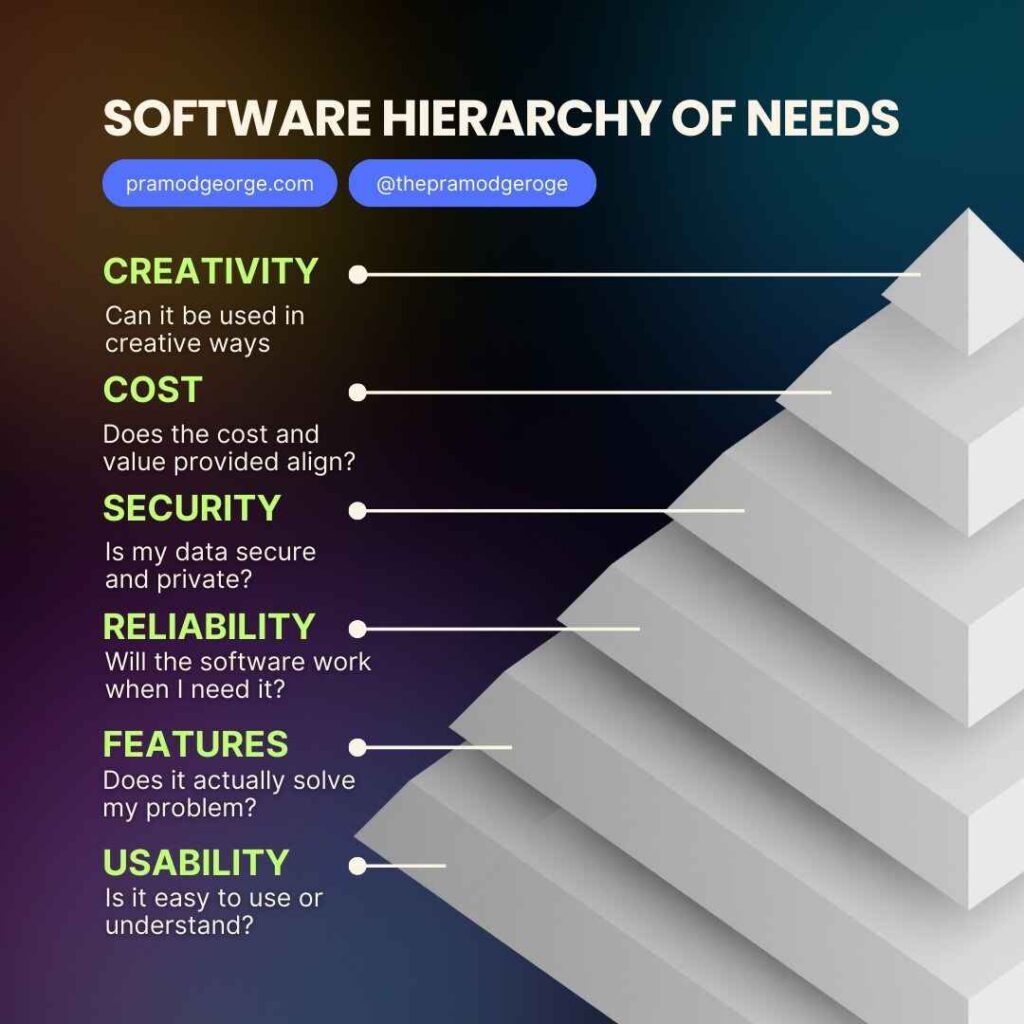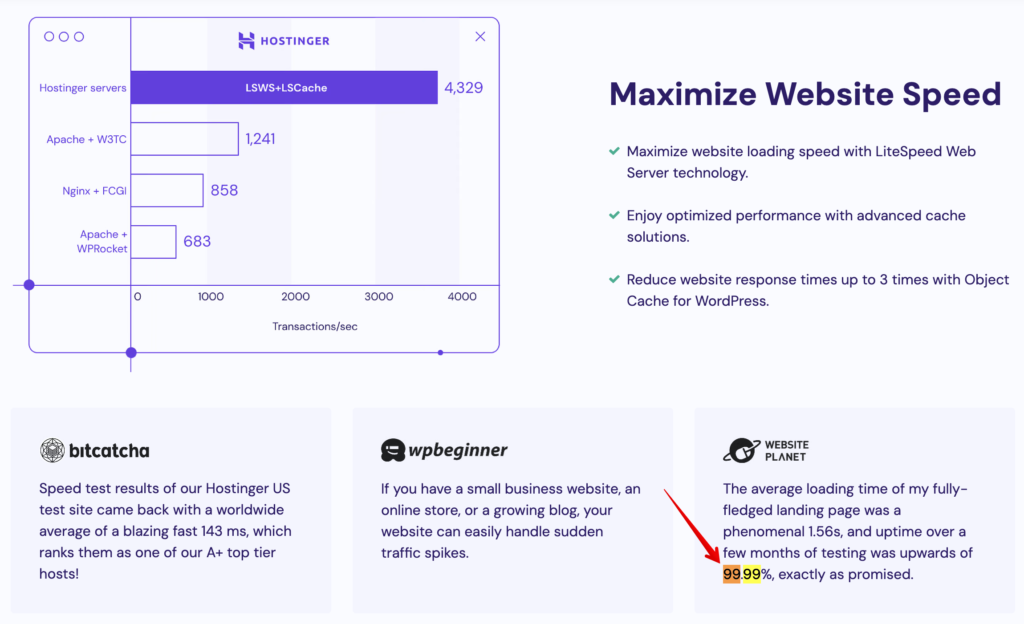Building great software that people love to talk about and share organically is hard.
How do you prioritise the right features?
But what if there was a framework to help you?
For the last 13 years, I’ve closely observed how people use software and I discovered a pattern that beautifully represents how users evaluate and find satisfaction with the software they use.
I call it “The Software Hierarchy of Needs” and it shows you what people are actually looking for in a software.
Understanding this hierarchy will help you prioritize the right things and build smarter solutions – faster.

Why a Pyramid?
The pyramid structure is not just a visual choice – it’s a fundamental aspect of the concept.
Here’s why:
- Foundation First: Like building a house, great software starts with a solid foundation. The pyramid shape emphasises that lower levels must be addressed before moving up.
- Interdependence: Each level supports the ones above it. Neglecting lower levels can cause the entire structure to become unstable.
- Prioritization: The pyramid helps founders, developers and product managers prioritise their efforts, focusing on the most critical needs first.
- User Journey: As users’ basic needs are met, they naturally progress to higher-level concerns, mirroring their journey up the pyramid.
Let’s explore each level of this hierarchy, starting from the foundation:
Usability: The Bedrock of Software Success
One of the first things I learned was the importance of usability.
This became clear when I saw how users struggled with complex interfaces.
Even the most powerful software became useless if people couldn’t figure out how to use it.
Usability is fundamental and non-negotiable.
I remember a conversation with a small business owner who had invested in an expensive CRM system.
Despite its powerful features, he found it so complicated that he abandoned it after a few weeks. This experience taught me that simplicity and intuitiveness are crucial.
“According to a study by the Nielsen Norman Group, 88% of users are less likely to return to a website after a bad user experience.”
Nielsen Group
Real-world Example: Consider the success of Dropbox. Its simple drag-and-drop interface revolutionized how people think about cloud storage. In contrast, many early enterprise content management systems failed despite robust features, simply because they were too complex to use.
Users must feel confident and competent when using the software, which directly impacts their willingness to continue using the tool.
This is why so many modern design systems are moving to a minimalistic design – to not create apprehension in the user’s minds when they land of the homepage.
Action Item 1: Ask yourself if your platform is intuitive to use. Can users learn to use the platform without much help. If you app is complex, does it have sufficient learning resources that are easily accessible to help them understand and become comfortable using your software.
Action Item 2: Conduct regular usability testing throughout the development process. Use heat maps and user session recordings to identify pain points in your interface.
Features: Solving Real Problems
After ensuring usability, the next layer in the hierarchy is features.
Once users can easily navigate your software, the next question is whether it does what they need it to do.
Users care deeply about whether the software solves their specific problems.
A meeting with a project manager highlighted this point.
He used a popular project management tool but was annoyed because it lacked a key time-tracking function.
This conversation proved that having the right features is more important than having many features.
Real-world Example: Slack succeeded in the crowded messaging app market by focusing on features that solved real problems for teams. Eg: easy file sharing and customizable notifications.
A Pendo study found that 80% of features in the average software product are rarely or never used.
Action Item: Track features to find out which ones are most used and valued. Review your feature set often to match user needs.
Reliability: Consistency is Key
As I continued evaluating what users were talking about. Reliability emerged as another critical factor.
Users need to have the confidence that the software will work when they need it.
This builds trust which is crucial for long term loyalty of users.
I learned this lesson firsthand when one startup I worked with faced a crisis due to a server outage.
We saw a huge drop in active users the next day – because they lost confidence that the software was “reliable”.
"Users need to trust that the software will work when they need it, which is fundamental to their sense of security and stability in their professional tasks."Pramod George
The incident proved to me the importance of offering a reliable, stable service.
This is why many web hosting platform’s primary marketing line is “99% uptime”.

Key Question: “Will the software work when I need it?”
According to Gartner, the average cost of IT downtime is $5,600 per minute.
Security: Protecting Trust
With usability, features, and reliability addressed, users turn their attention to security next.
Key Question: “Is my data secure and private?”
In our digital age, security is non-negotiable.
In an age of increasing cyber threats, users want a guarantee that their data is safe.
WhatsApp’s success can be partly attributed to its end-to-end encryption, which gave users confidence in the privacy of their communications
This report by Bitdefender found that businesses can lose upto 58% of customers after a data breach.
83% of consumers in the US claim they will stop spending at a business for several months immediately after a security breach. 21% will never return to that business. In Canada, the results were similar. 58% of consumers claim they will stop spending at a business for several months post-breach, and a fifth will abandon their services outright.
An IT director shared his experience of a data breach and its devastating impact on his company’s reputation.
Would you continue to use a software where your data and privacy were leaked?
This made it clear that security is non-negotiable.
Users must feel confident that their information is secure.
This affects their peace of mind and trust in the software.
Cost: Balancing Value and Price
As my understanding deepened, I realized that cost was also a significant factor.
Key Question: “Does the cost and value provided align?”
However, it wasn’t just about the price tag but the value provided.
This layer corresponds to Maslow’s esteem needs—users need to feel that they are making a wise investment that offers real value.
In software pricing, price is the amount a buyer pays for a product or service, while value is what the buyer perceives as the benefits they’ll get from it
I spoke with a startup founder who chose a slightly more expensive tool (Even though they were cash strapped) because it offered better support and long-term value.
This conversation taught me the importance of balancing cost with value.
Users are willing to invest in software that they perceive as valuable and beneficial, which enhances their sense of accomplishment and self-worth.
More Reading on how to better price your products.
Creativity: Enabling Innovation
Key Question: “Can it be used in creative ways?”
At the top of our pyramid is creativity – the ability for users to innovate and express themselves through your software.
This layer aligns with Maslow’s self-actualization needs.
Once all the basic and psychological needs are met, users seek to use the software to its fullest potential, pushing boundaries and enabling innovation.
A graphic designer showed me how she used a standard illustration tool in unconventional ways to create stunning artwork.
This demonstrated the power of creativity.
At this level, users are not just looking for solutions to problems but also for opportunities to innovate and express their creativity, which leads to personal and professional growth.
Real-world Example: Minecraft’s open-ended gameplay has led to incredible user-generated content, from realistic cityscapes to working computers within the game.
Data Point: A study published in the Journal of Creative Behavior found that software tools that support creative expression have a 72% increase in revenue compared to tools that doesn’t have this opportunity.
Action Item: Create spaces for users to share creative uses of your software. Incorporate this feedback into development to foster a cycle of innovation.
Now, reading about this framework and profiting from it are 2 different things. The best way to profit from this framework is to use it to build and launch your own SaaS. Now if you’ve never built SaaS before, and you’re not sure where to start, I’ve got you covered.
In 2023, I built and launched 2 profitable apps in 2 months, by myself, without knowing to code. This helped me achieve financial freedom.
Want to learn more? Start here?👇🏼
















